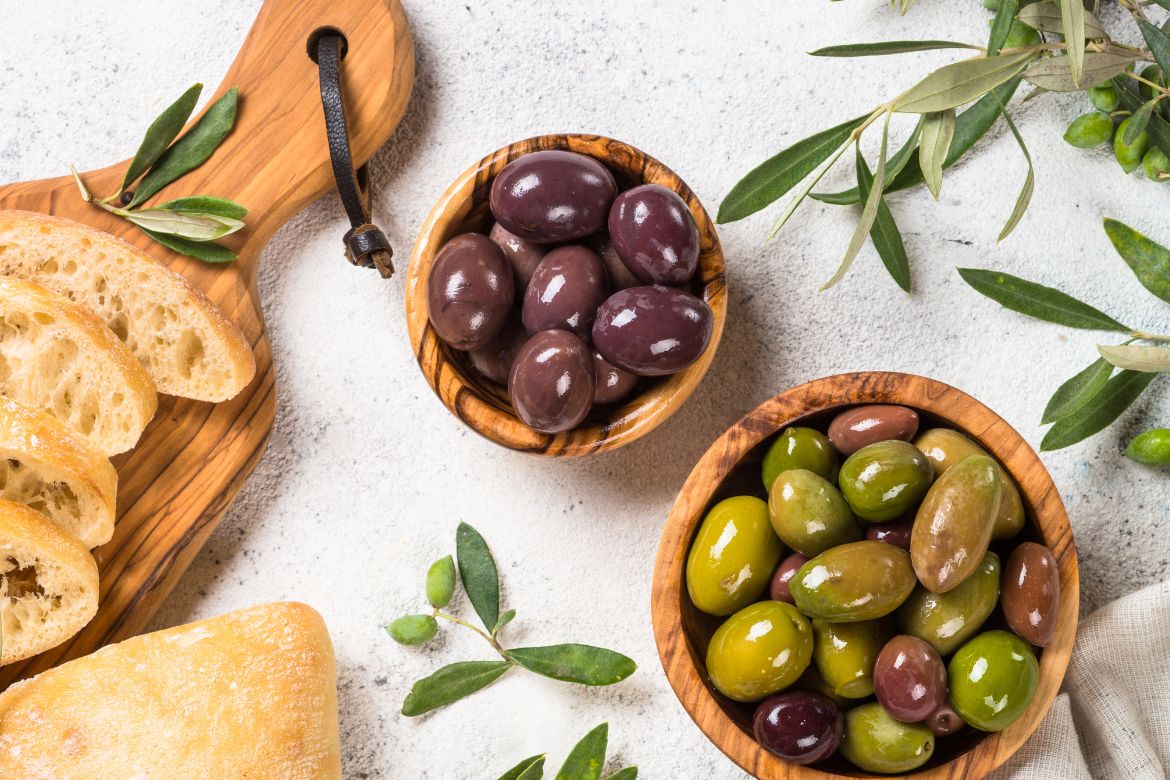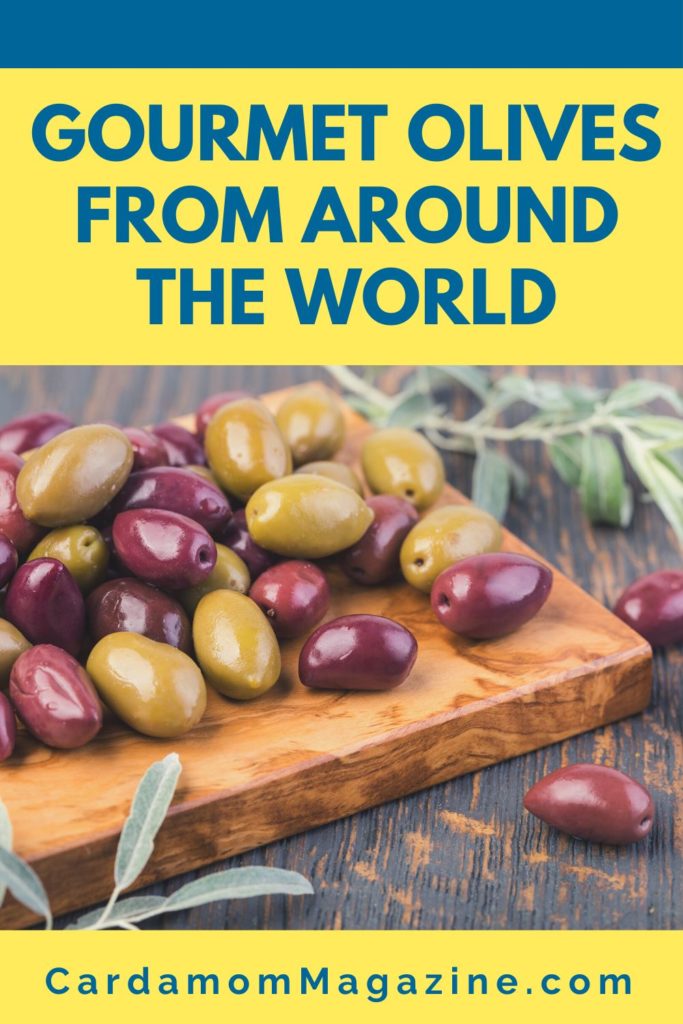Enjoy this virtual tour of gourmet olives from around the world. Kalamata, Manzanilla, Castelvetrano, Picholine, and more!
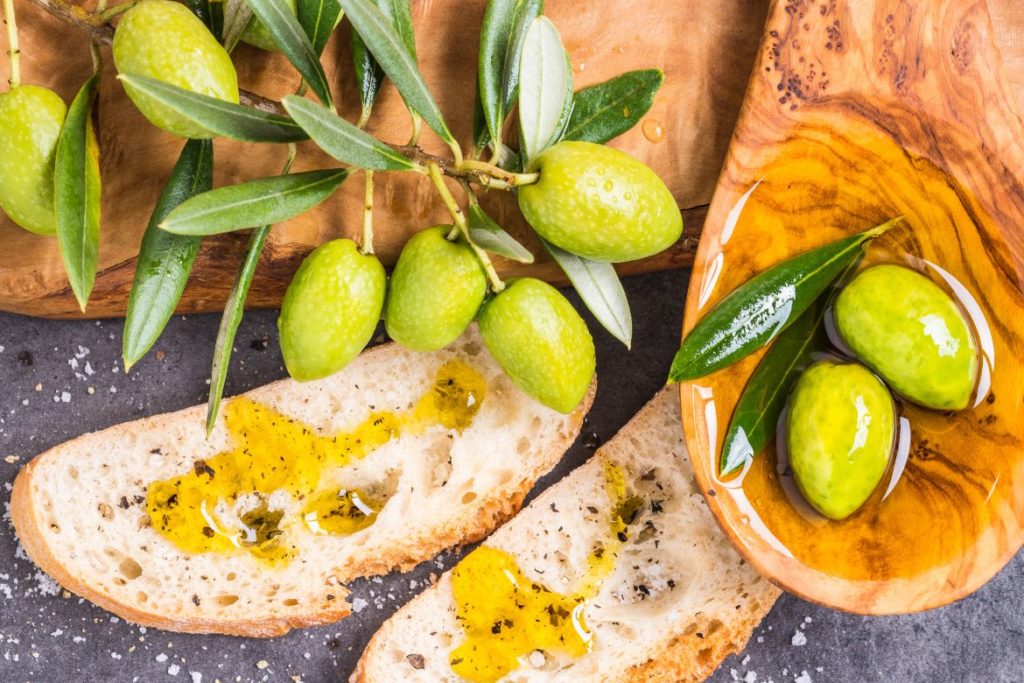
Additional reporting from Joan Carlson Bardin, Cardamom Magazine Research Editor.
Gourmet olives, those small, unassuming orbs of flavor, have captured the hearts and palates of food enthusiasts worldwide. These tiny delicacies are much more than mere ingredients; they represent centuries of culinary traditions. In this blog post, we’ll embark on a mouthwatering journey to explore the diverse and captivating world of olives from around the globe.
So let’s get started on our tour of the world’s leading olive regions and explore some of their delicious olives.
Kalamata Olives: A Taste of Greece
Kalamata olives, named after the city of Kalamata in Greece, are perhaps one of the most famous olive varieties globally. These dark, almond-shaped olives are known for their deep, rich, fruity flavor and smooth texture. Kalamata olives are typically harvested at peak ripeness and can be found both in brine and in oil. They are a key ingredient in Mediterranean cuisine, frequently used in Greek salads, tapenades, and as a garnish for dishes like Greek moussaka. Their distinct flavor profile, a delightful blend of slightly tangy and briny with a hint of sweetness, makes them a popular choice for olive enthusiasts.
Recommendation: Peloponnese Kalamata Olives
See Also | The Ikarian Diet: Culinary Adventures in Greece
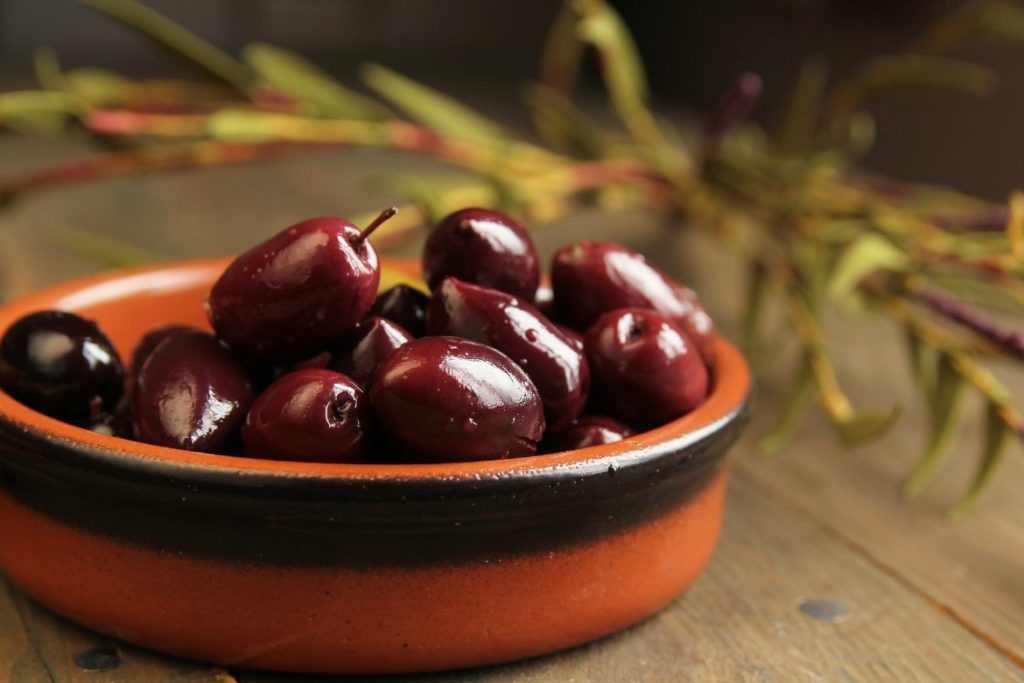
Picholine Olives: Crispy, Crunchy Olives from France
Picholine olives, originating in France, are renowned for their slender, elongated shape and vibrant green color. These olives have a crisp, crunchy texture and a distinctly tart and citrusy flavor profile. Typically, they are harvested young and then brine-cured, resulting in a delightful balance of salty and tangy notes. Picholine olives are often served as a snack, accompanied by a glass of wine, and can also be used in various Mediterranean dishes and salads.
Recommendation: Green Picholine Olives by Barrel
Cerignola Olives: Gourmet Olives from Southern Italy
Cerignola olives, native to the Puglia region of Italy, are one of the largest olive varieties in the world. They are prized for their meaty and firm texture, making them an ideal choice for snacking. Cerignola olives are available in both green and black varieties, with the green being more common. These olives have a mild, slightly nutty flavor with a touch of sweetness. You can enjoy them marinated or stuffed with various ingredients like cheese, garlic, or citrus peel, adding to their versatility in both Italian and international cuisine.
Recommendation: Cerignola Italian Olives
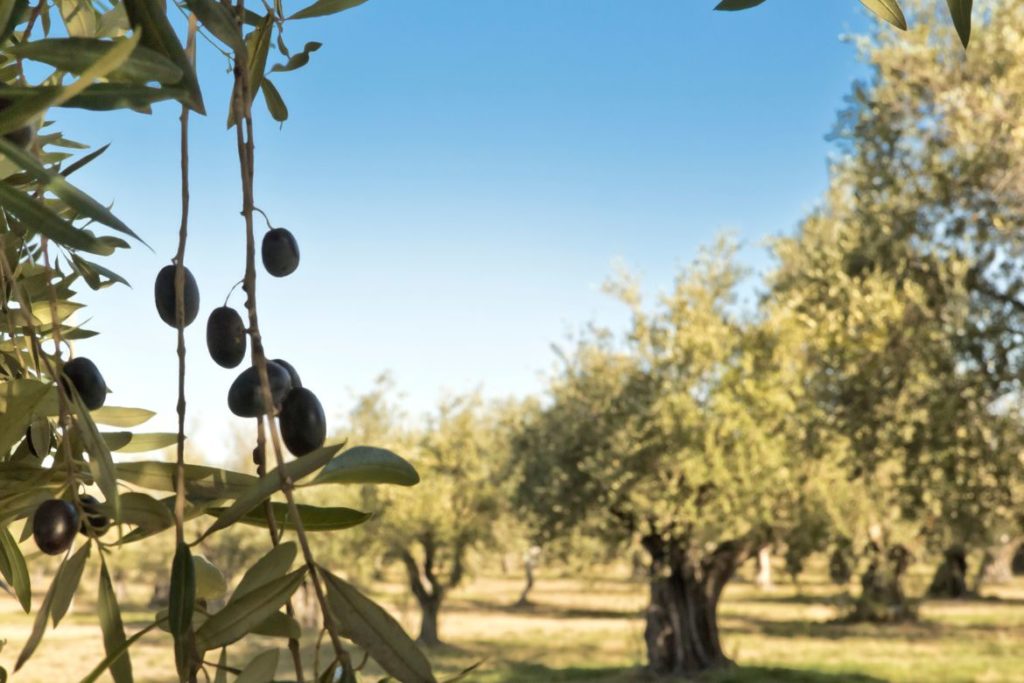
Gift Idea 🎁 igourmet Olive Lover’s Gourmet Gift Box (assortment of olives from Italy, France, Greece, and Spain)
Manzanilla Olives: A Spanish Tapas Favorite
Manzanilla olives, originally from Spain, are small, green olives with a slightly nutty and briny flavor. Their name refers to their resemblance to small apples (manzanas in Spanish). These olives have a crisp and firm texture, making them a popular choice for garnishing cocktails like martinis. They are also frequently feature in tapas dishes, salads, and Spanish-style appetizers, thanks to their appealing balance of saltiness and mild fruitiness.
Recommendation: Losada Manzanilla Olives
Gaeta Olives: The Wrinkled Italian
Gaeta olives, originating in the town of Gaeta, Italy, are small, wrinkled, and dark brown to black in color. They have a slightly salty and intensely earthy flavor with a hint of bitterness. Gaeta olives are typically dry-cured, often in a mixture of salt and oil, which concentrates their flavor and enhances their shelf life. These olives are a staple in Italian cuisine, such as pasta dishes, antipasto platters. They’re also a flavorful addition to Mediterranean-style pizzas.
Recommendation: Italian Gaeta Olives
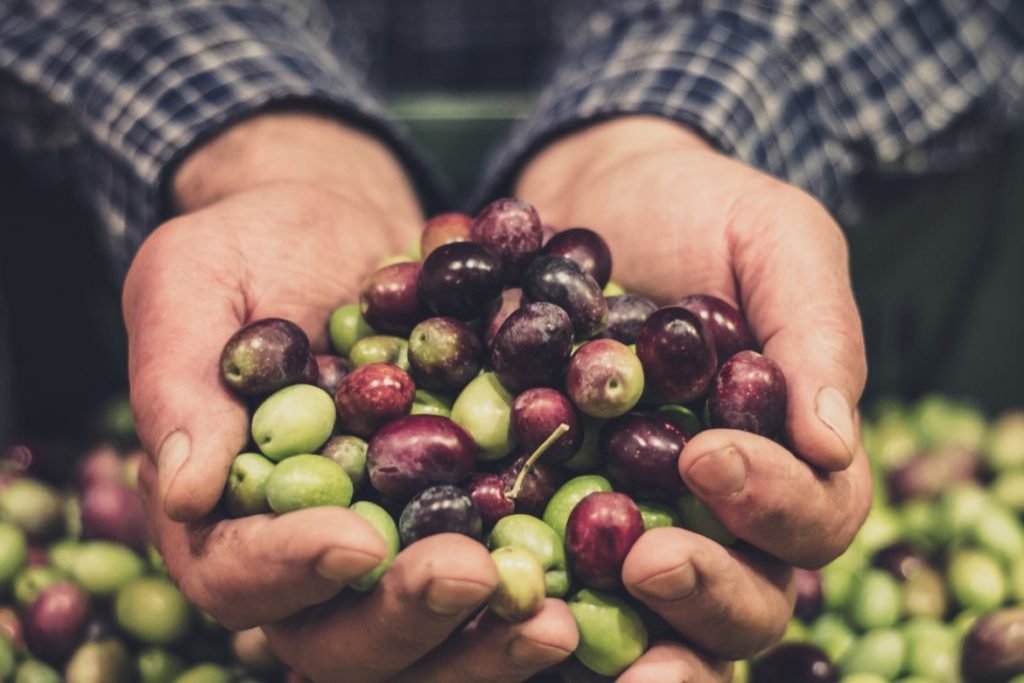
Gift Idea 🎁 Chef Ole Olivia Gourmet Set of Spanish Olives
Gemlik Olives: A Taste of Coastal Turkey
Gemlik olives, also known as Gemlik black olives, originate from the coastal region of Gemlik in Turkey. These gourmet olives are small to medium-sized with a deep purple to black color and a wrinkled appearance. Gemlik olives are notable for their rich, fruity flavor and a balanced combination of brininess and a slight sweetness. They are typically brine-cured and often seasoned with herbs, spices, and sometimes a touch of vinegar. These olives are a common choice in Turkish and Mediterranean cuisine, frequently found in meze platters, salads, and olive oil-based dishes.
Recommendation: Marmara Birlik Gemlik Black Olives
Arbequina Olives: Fruity, Nutty Olives from Catalonia
Arbequina olives are a Spanish variety originally from Catalonia but are now grown in various regions worldwide, including California. These small, oval-shaped olives have a distinctive fruity and slightly nutty flavor with a mild peppery finish. They are frequently used to produce high-quality extra virgin olive oil and are also enjoyed as table olives. Arbequina olives are versatile and can be included in a wide range of dishes, from Mediterranean salads to tapenades.
Recommendation: Dequmana Arbequina Olives
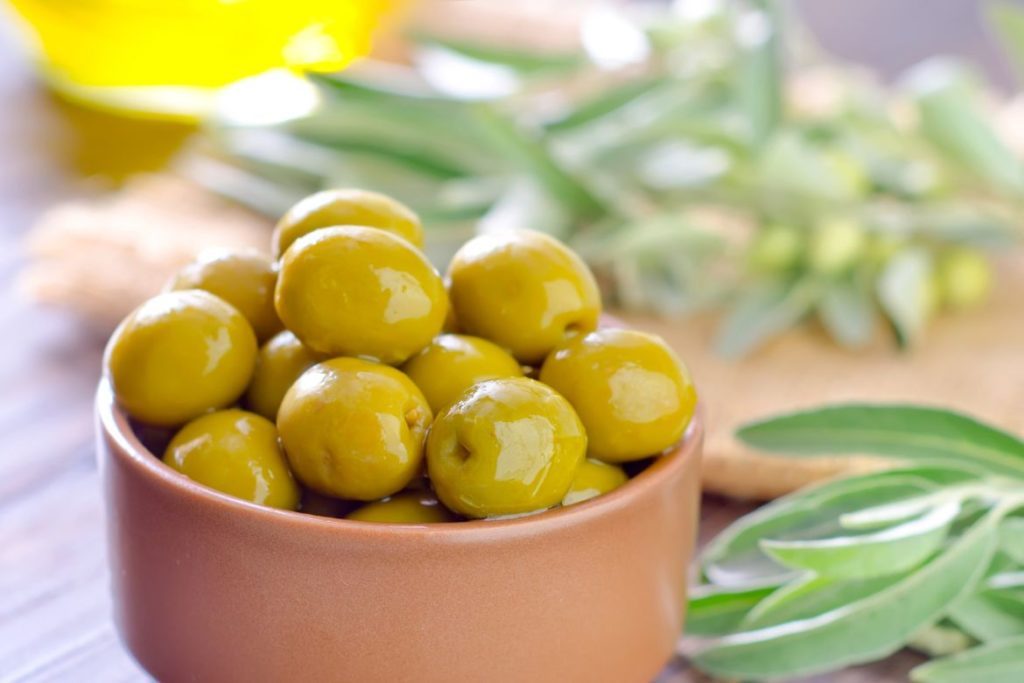
Gift Idea 🎁 Easy Olive Cookbook: An Olives Cookbook Filled with 50 Delicious Olive Recipes
Beldi Olives: A Moroccan Specialty
Beldi olives, also known as Moroccan Beldi olives or simply Beldi olives, are a traditional variety of olives native to Morocco. These olives feature a wrinkled appearance and dark, reddish-brown to black color. Beldi olives are typically smaller and more oblong than other olive varieties, with a uniquely intense, smoky flavor. They are often dry-cured and preserved in salt, which enhances their rich taste and firm texture. Beldi olives are a staple in Moroccan cuisine, commonly used in tagines, salads, and as a flavorful addition to various dishes. Their distinctive taste and rustic charm give them a special place in Mediterranean and Middle Eastern culinary traditions.
Recommendation: Mina Black Beldi Olives
Castelvetrano Olives: Green Olives from Sicily
Castelvetrano olives are a type of green olive variety hailing from the town of Castelvetrano in Sicily, Italy. These gourmet olives are renowned for their distinctive bright green color and unique, sweet, and mildly nutty flavor. They have a meaty, firm texture and are often harvested at their peak ripeness, which contributes to their exceptional taste and vibrant appearance. Castelvetrano olives have gained popularity among food enthusiasts and are frequently enjoyed as a snack, appetizer, or addition to salads and antipasto platters. Their delightful taste and striking green hue make them a sought-after ingredient in Mediterranean cuisine and beyond.
Recommendation: Sanniti Whole Castelvertrano Olives

Tasty Tip: When serving olives, it is also important to consider the pairing with drinks and other foods. For example, acidic white wines like Sauvignon Blanc or Vermentino pair well with olives, as do light beers and aperitifs like fino sherry or vermouth. Olives also pair well with cheeses such as feta or blue cheese, and with charcuterie such as prosciutto or salami.
Azeitona Galega Olives: A Portuguese Delight
Azeitona Galega, also known as Galega olives, originate from Portugal and are a staple in Portuguese cuisine. These small to medium-sized olives come in various shades of green and have a slightly nutty and earthy flavor with a mild brininess. Azeitona Galega olives are often brine-cured. You’ll find them in numerous Portuguese dishes, including salads, stews, and appetizers. Their versatility complements a wide range of flavors in both traditional and modern Portuguese cooking.
Recommendation: OlivaMira Portuguese Whole Galega Mixed Olives
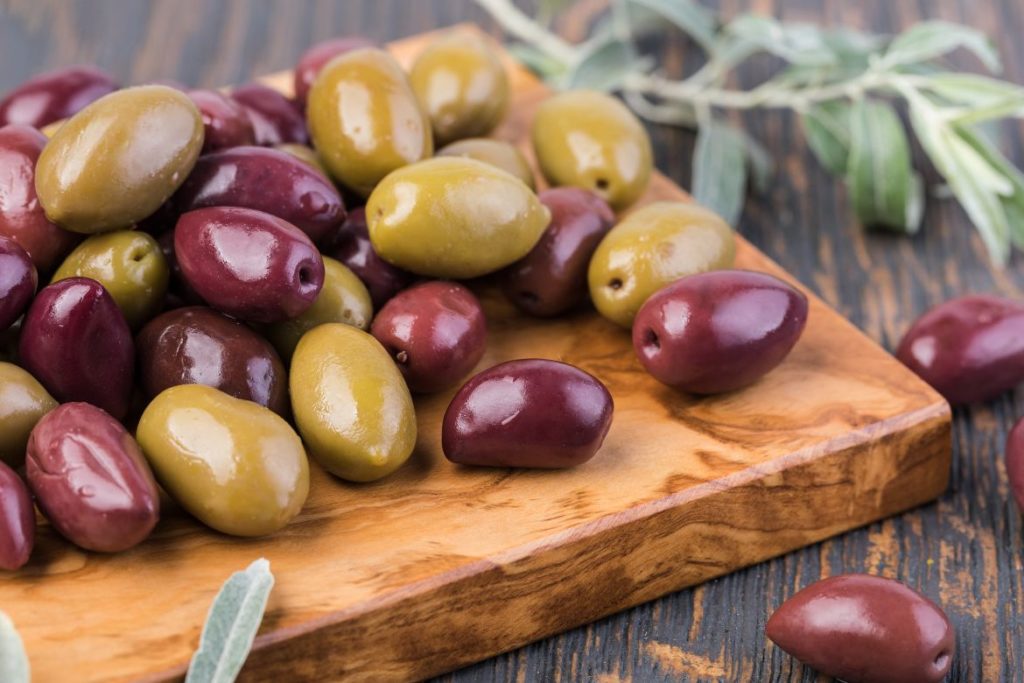
Tasty Tip: Make olive skewers with different types of olives mixed with other ingredients like cherry tomatoes, mozzarella balls, and basil leaves for a fun appetizer.
Lucques Olives: From Languedoc in the Heart of France
Lucques olives also known as Luques or Lucca olives, originate from the Languedoc region of France. They feature an elongated, crescent-shaped appearance, bright green color, and tender, meaty texture. Lucques olives have a fruity and buttery flavor with a subtle nuttiness and a mild, pleasant brininess. Serving ideas include serving as a gourmet snack or appetizer, either plain or marinated with herbs and citrus zest, showcasing their exceptional quality and taste.
Recommendation: Green Lucques Olives by Barrel
Mission Olives: Native to California
Mission olives from California, are medium-sized, purplish-black olives with a mildly sweet and fruity flavor. Their name comes from the California missions where Spanish missionaries initially cultivated them. These olives are often used for both table olives and olive oil production. You’ll find mission olives in various American and Mexican dishes, as well as in salads and tapenades.
Recommendation: Mission Olives from the Temecula Olive Oil Company
Summing Up Your World Tour of Gourmet Olives 🫒🫒🫒
Each of these olive varieties carries its unique characteristics, making them a flavorful addition to various cuisines and culinary traditions, whether as a snack, in salads or as a key ingredient in savory dishes and appetizers. Enjoy your olive tasting!
Questions About Gourmet Olives
Olive production follows a curing process, which removes the natural bitterness and makes them palatable. There are various methods, including brining (soaking in salt water), dry-curing (exposing to air and salt), and lye-curing (treating with an alkaline solution). After curing, growers can further marinate their olives with herbs, spices, or oil for added flavor.
The color of olives relates to their ripeness when harvested. Green olives are typically picked before they fully ripen and turn black. Green olives tend to be firmer and have a slightly bitter, more tangy taste. As olives ripen and darken, they become black or purplish-black and develop a richer, fruitier flavor and softer texture. However, it’s essential to note that the color alone does not always determine the taste, as some green olives can also be quite mild.
Olives are a healthy food choice in moderation. They are a good source of monounsaturated fats, which are associated with heart health. Olives also provide essential nutrients like fiber, vitamins (such as vitamin E), and minerals (such as iron and calcium). Additionally, they contain antioxidants and compounds that may have various health benefits, such as reducing inflammation. See Olives 101: Nutrition Facts and Health Benefits for more information on how to make olives a part of your healthy diet.

